

















Our Favorite Saturn Pictures From the Cassini Spacecraft
The NASA probe has been running rings around Saturn for 13 years—take a look at how its discoveries forever changed our view of the planet.
Saturn has been our companion since the dawn of humankind, wandering across the heavens as one of the brightest dots of light visible to the naked eye. Ancient cultures as far back as Babylon tracked its movements; many people thought the creamy-colored star represented a divine presence.
Now, a spacecraft that turned this dot of light into a cosmic wonderland is about to make the ultimate sacrifice for science and hurl itself into Saturn’s atmosphere, plunging deep inside the gas giant until gravity and friction rip it apart.
NASA’s Cassini spacecraft built upon the work of the Voyager mission, twin probes that sailed past Saturn in the 1980s. The Voyagers redrew our understanding of the planet’s stormy face and gathered the first tantalizing hints that some of its moons might be more active than expected. But the twins spent only a few weeks at Saturn and then parted ways, each heading farther into the solar system.
With its arrival in 2004, Cassini became the first spacecraft to actually orbit the ringed giant. For 13 years, has been circling Saturn in tangled loops, pirouetting past rings and moons to capture some of the most detailed views ever of these exotic objects.
The images and data sent back to Earth opened the celestial floodgates. Through Cassini’s eyes, we saw a menagerie of more than 60 moons—some small and pockmarked with craters, some large enough to hold oceans and dense atmospheres. We saw diminutive balls of ice sculpting Saturn’s rings and titanic storms raging across the planet. And Cassini gave us the first close look at Saturn’s atmosphere shifting with the seasons.
A few times, the probe even turned its eyes homeward and took snapshots of Earth, a pale blue dot drifting behind the veil of another world's rings.
In a few short days, Cassini will dive to its doom—but the mission leaves a rich legacy in the form of spectacular images and profound scientific insights. After all, the probe is being sent to its death so that we can protect two moons that Cassini tells us may be refuges for exotic forms of alien life.
Such mysteries are far too enticing to ignore. Perhaps someday, another robotic explorer will sail toward Saturn and turn up wonders we have yet to imagine.
Related Topics
You May Also Like
Go Further
Animals
- Fireflies are nature’s light show at this West Virginia state parkFireflies are nature’s light show at this West Virginia state park
- These are the weird reasons octopuses change shape and colorThese are the weird reasons octopuses change shape and color
- Why young scientists want you to care about 'scary' speciesWhy young scientists want you to care about 'scary' species
- What rising temperatures in the Gulf of Maine mean for wildlifeWhat rising temperatures in the Gulf of Maine mean for wildlife
- He’s called ‘omacha,’ a dolphin that transforms into a man. Why?He’s called ‘omacha,’ a dolphin that transforms into a man. Why?
Environment
- What rising temperatures in the Gulf of Maine mean for wildlifeWhat rising temperatures in the Gulf of Maine mean for wildlife
- He’s called ‘omacha,’ a dolphin that transforms into a man. Why?He’s called ‘omacha,’ a dolphin that transforms into a man. Why?
- The northernmost flower living at the top of the worldThe northernmost flower living at the top of the world
- This beautiful floating flower is wreaking havoc on NigeriaThis beautiful floating flower is wreaking havoc on Nigeria
- What the Aral Sea might teach us about life after disasterWhat the Aral Sea might teach us about life after disaster
History & Culture
- Scientists find evidence of ancient waterway beside Egypt’s pyramidsScientists find evidence of ancient waterway beside Egypt’s pyramids
- This thriving society vanished into thin air. What happened?This thriving society vanished into thin air. What happened?
Science
- Why pickleball is so good for your body and your mindWhy pickleball is so good for your body and your mind
- Extreme heat can be deadly – here’s how to know if you’re at riskExtreme heat can be deadly – here’s how to know if you’re at risk
- Why dopamine drives you to do hard things—even without a rewardWhy dopamine drives you to do hard things—even without a reward
- What will astronauts use to drive across the Moon?What will astronauts use to drive across the Moon?
- Oral contraceptives may help lower the risk of sports injuriesOral contraceptives may help lower the risk of sports injuries
- How stressed are you? Answer these 10 questions to find out.
- Science
How stressed are you? Answer these 10 questions to find out.
Travel
- A guide to Philadelphia, the US city stepping out of NYC's shadowA guide to Philadelphia, the US city stepping out of NYC's shadow
- How to make perfect pierogi, Poland's famous dumplingsHow to make perfect pierogi, Poland's famous dumplings
- The best long-distance Alpine hike you've never heard ofThe best long-distance Alpine hike you've never heard of
- Fireflies are nature’s light show at this West Virginia state parkFireflies are nature’s light show at this West Virginia state park
- How to explore the highlights of Italy's dazzling Lake ComoHow to explore the highlights of Italy's dazzling Lake Como
- Going on a cruise? Here’s how to stay healthy onboardGoing on a cruise? Here’s how to stay healthy onboard




